
About the Author
Amanda Sarmientos is a student at Florida International University Honors College, pursuing a Bachelor’s Degree in Psychology with a Pre-Law certificate. She is a Cuban immigrant who came to the U.S. at the age of 10, and is passionate about creating meaningful change for the situation of her home country through her aspirations of becoming an attorney.
___________________________________
France Encounter/ Over Under Paris as Text

“Walking Thoughts”
By Amanda Sarmientos of FIU in Paris, France 8th of July, 2023.
The sign on the station wall read ‘Champ de Mars’ as I hurried to exit the car. I was immediately greeted, while exiting the station, by the same sheltering trees that populate a majority of the streets of Paris. Thankful for the shade, I set about my walk.
I walked around the lively neighborhood for the entirety of the morning, passing souvenir shops, street vendors, countless bars and restaurants. After the first few minutes of walking aimlessly I spotted the Eiffel tower, I sat on the champ de mars park to look at the tower, and after that I contemplated the tourists and vendors interacting by the bank of the seine river.
Different aspects of Paris occupied the great majority of my thoughts during the time I dedicated to getting lost around the streets near the Champ the Mars station. Paris and Miami differ in countless ways. Some more obvious ones like city architecture can be really appreciated without looking too close or for too long at either city. Miami buildings are made to look modern and square without much ornamentation, whereas Parisian buildings in this area were polished, ornamental and had a special something that set them apart. The Miami city skyline relies on the lights off the endless skyscrapers and their reflection on the water for the buzzing city effect that many find so enthralling. Paris on the other hand, shines most at sunset time, where the breeze smells of wine, stinky cheese and cigarettes and the seine water sparkles as the river cruises sail by. Feeling both like a big city, and small town all at once.
A similarity between the cities was the population of people living in the street. In Miami you can find a large majority of homeless people near the city center, but in the case of Paris, I found a large majority to reside along the more “suburban” areas of the city. Near the city center you find mostly vendors and sellers, tourists, photographers, entertainers, crepe stands, souvenir shops and a concoction of coffee shops perfect for sitting for a coffee break at any point during the day. Seeing tents and belongings on the sides of the highway in Paris gave me the familiar feeling I get when I encounter someone who lives on the street in Miami. I wondered what kind of programs or help is offered here and how it compares to that of the U.S..
In addition to noting similarities and differences between Paris and Miami, I spent a long time wondering about the stories of the strangers I encountered around the Eiffel tower. I saw a particular little boy and his dad, staring and smiling while glancing up. The little boy hurried his dad signaling him to come quick, jumping around of excitement upon seeing the massive iron structure that looked so grand but so delicate at the same time. I thought about the depth and importance of the memory I was watching them make. And how it related to me and to so many others like me. I found it beautiful but sad that so many families get to have these memories and see the beautiful views of this magical city and so many others don’t. I thought about my grandparents, my cousins, my uncles, and aunts. All of whom have been born, have lived and will die without ever seeing the Eiffel tower, or the shining waters of the seine at sunset, or wave to the passing cruises while drinking wine at the riverbank. I thought about the privileges and experiences we so often take for granted. The many details we overlook and the beauty that the world offers every day in abundance, which we often don’t take the time to appreciate nor realize.
Versailles as Text

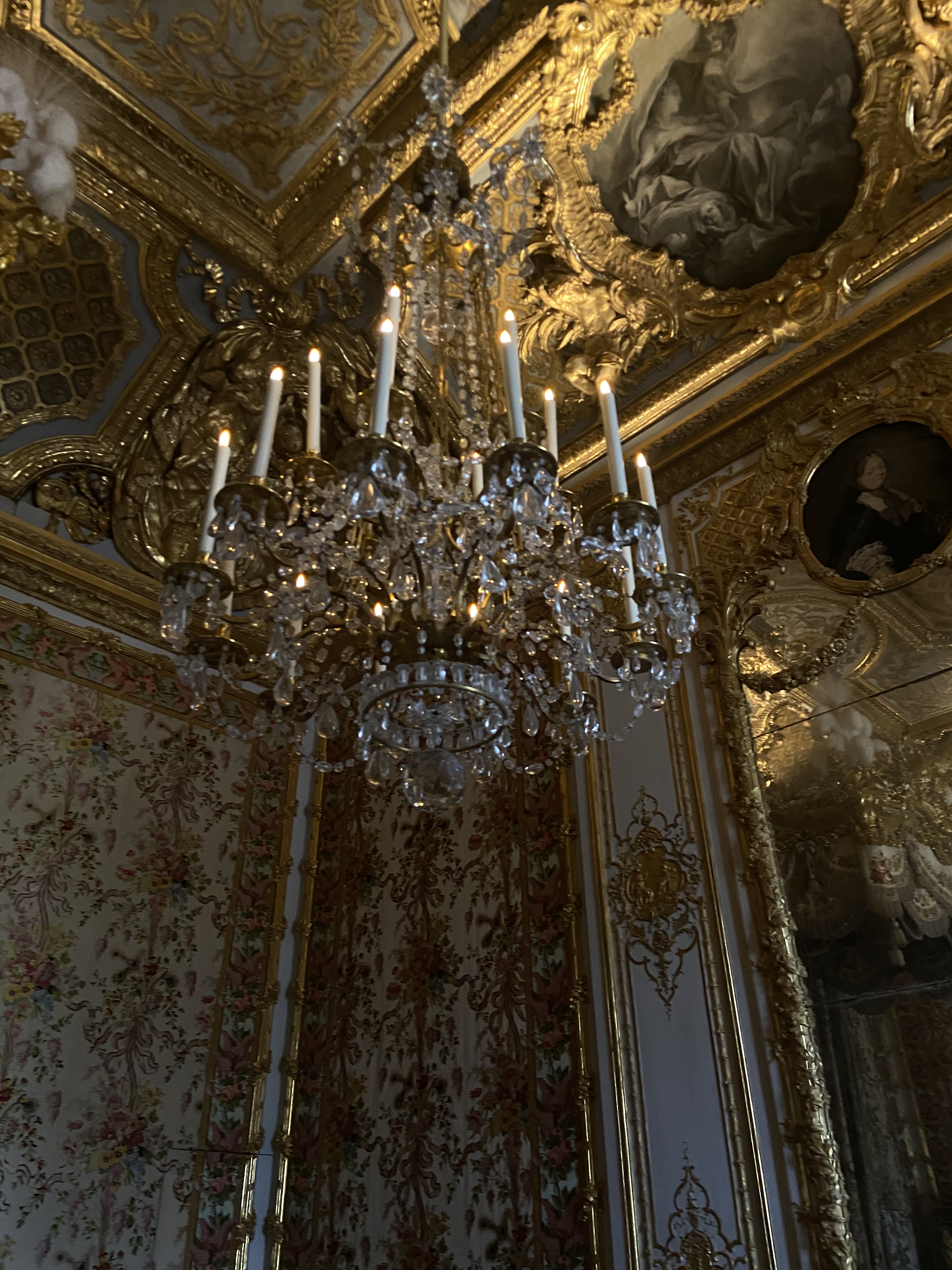

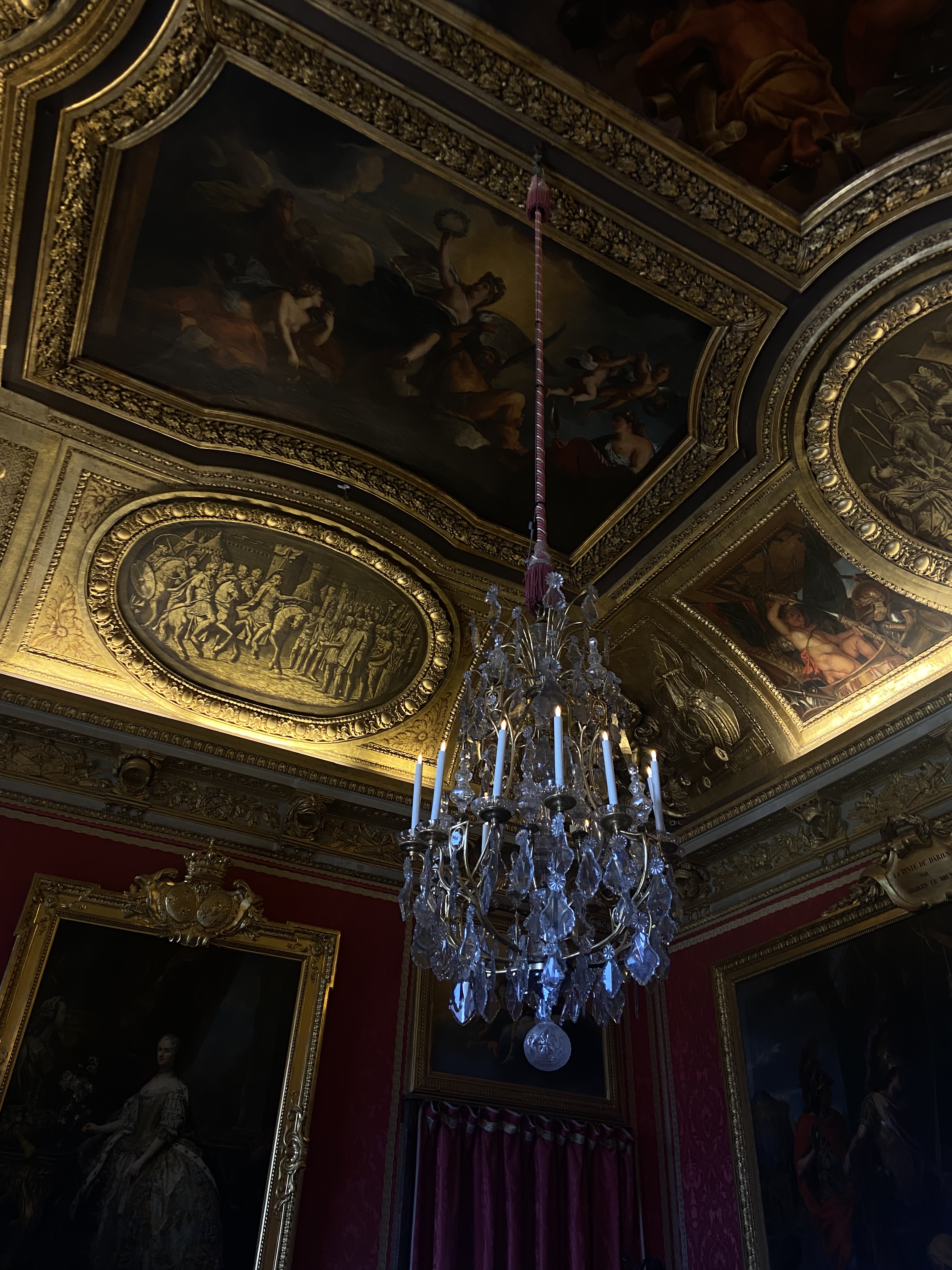
Photos by Amanda Sarmientos CC// by 4.0
“The Gold Hides the Tears”
By Amanda Sarmientos of FIU in Paris, France 13th of July, 2023.
Massive, opulent, golden gates surrounded the entrance to the most elegant and extravagant display of wealth I’ve ever seen. The palace of Versailles stood massively in the center and extended for as long as the eye could see. Inside, out and around, Versailles is a statement. A massive and expensive statement that signifies the wealth and power of the French state and of its king. But within every block and stone of the façade, lies a history of abuse, tyranny and hardship.
Initially a hunting lodge for Louis XIV’s father, no one expected Versailles to become what it has. One of the most widely known and visited castles in France and in Europe, and a precious piece of French history and culture. A very important money machine for the French government today, from the number of touristic visits it receives every day, regardless of the weather.
With the design and renovation of Versailles, Louis XIV brought about the birth of the Rococo artistic style, placing France in the books which had been dominated for so long by Italian styles such as Renaissance and Baroque. Rococo is particularly recognizable on the walls of Versailles by its busy and over the top ornamentation. Not an ounce of simplicity in sight when inside the walls of the castle. This adds to the very purpose of the king in undertaking this renovation and making Versailles what is it today, to project to the people and the world, that there is no simplicity in the French monarchy, only opulence and power and gold.
The castle in all its grandeur cannot erase from my mind the sacrifices that the common folk were obligated to make in order for the wishes of the king to be fulfilled. The kids who starved, mothers who suffered and workers who lost limbs and battled sickness with no proper care or living conditions, they were all there with me, as I stared into the hall of mirrors, picturing the king and his court enjoying the wealth they stole from the hardworking people.
It’s thought provoking whether the actions of the king back then were justified because Versailles has become a source of revenue, pride, and achievement for the French people and culture today. But despite this, its very existence is a reminder of the hardships and hunger the people endured at the very same time the king and his court were enjoying a comfortable life and wasting the little money citizens had to make the castle, the gardens, and the luxurious lifestyle possible. No amount of glory should erase from the minds of the French people that although they now enjoy the palace and all it has to offer financially, touristically, and artistically, that palace was not made for them but rather for the king and his court’s enjoyment and reputation. That palace would not be what it is today If it wasn’t for the events that have made it more accessible to the people and made it to belong fully to the French government now comprised of “common folk”.
Paris as Text

“The City of Lights”
By Amanda Sarmientos of FIU in Paris, France 16th of July, 2023.
After living in Paris for two weeks, the city holds a special place in my heart. Like every heavily populated city, Paris has those unlikeable traits that make some people think twice about living there. The dirty city streets, the smelly public transportation areas, the constant smell of cigarettes, the lack of cold water and public bathrooms availability, just to name a few. However, being from one of the dirtiest and most unkept and underdeveloped countries in the world, the negative sides of Paris don’t bother me too much.
There are many things about the city which have stolen my heart. I love that no matter the time, if you’re in the city center there will always be people out and about. I love the big variety of restaurants, bars, cafes, and shops. I love that there is always a boulangerie nearby, and that necessities are almost always at a walkable distance. I love that the public transportation system although seemingly complicated at first, can really make your life much easier and save a lot of money. I love that when you’re feeling stuffy there is always a park waiting for you just a short walk away. You’re out in the middle of the city? No problem there are public parks all around with water and shade for you to take the break you need. I love that food doesn’t cost an arm and a leg and you can get wine for 3 euros at the supermarket.
Paris is filled with special people and special places where to sit and look for the stories all around. Tourists coming to see monuments for the first time, families out on walks, locals doing their groceries or buying a drink at a bar. Paris has taught me to look closely around me and appreciate not just the comfort and beauty of the moment I am living but also the moments and stories which are crossing paths with mine. You can learn a lot and appreciate a lot about life by simply being more open to experience the lives of those around you. Human interaction is a pleasant sensation when experienced willfully.
As a member of a society which is moving towards less and less human interaction as time progresses, living in Paris has been a breath of fresh air. Contactless payment, contactless delivery, contactless order, self check-in, self check-out: All technologies that make things more comfortable but at the same time isolate us from each other. Psychological studies have shown that humans are less stressed and overall happier when they have more social interactions with other people. Despite the availability of all these technologies in Paris, my experience taking public transportation and wondering about the city has allowed me to feel like I am interacting with other people and learning about their lives, even if we don’t always engage in conversation. I have felt this to be a special trait belonging to the city, which adds to that unpredictable air that makes Paris so appealing.
Reference:
Ortiz-Ospina, E. (2019, July 17). Are we happier when we spend more time with others?. Our World in Data. https://ourworldindata.org/happiness-and-friends
Resistance as Text
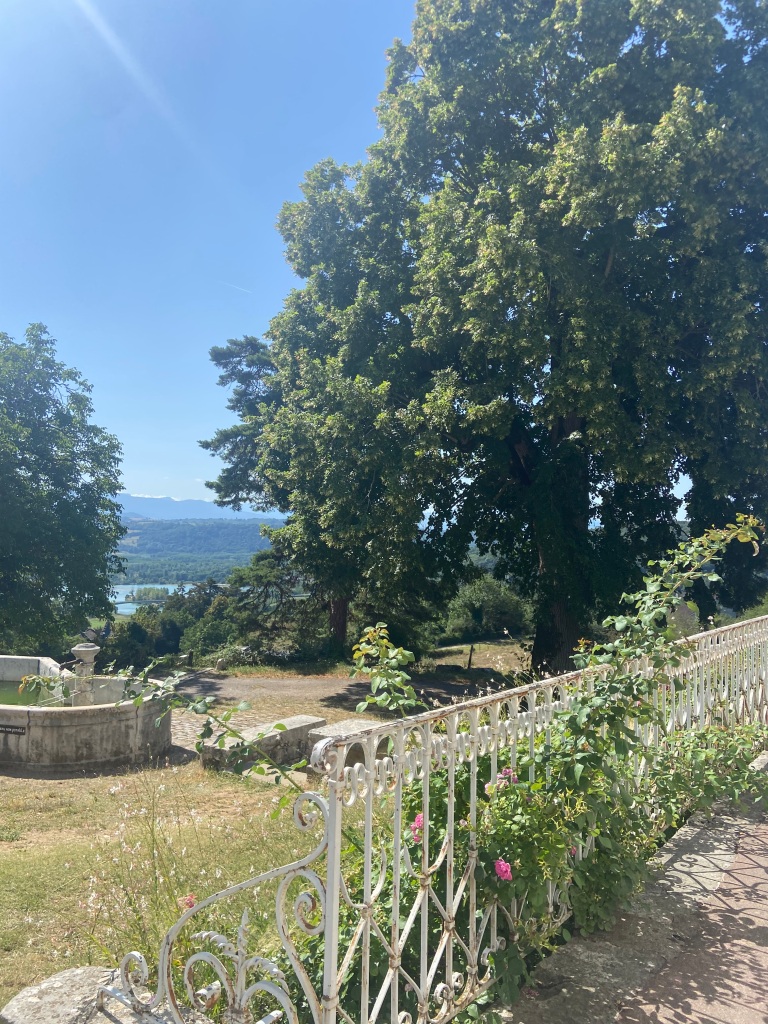
“Les Enfants de la Maison d’Izieu”
By Amanda Sarmientos of FIU in Paris, France 23rd of July, 2023.
The Maison d’Izieu overlooks the mountains. Whirling roads and giant stone cliffs accentuate the height you’re climbing as you near the home. The fields stretch for miles, full of wild flowers and farms. In front of the house the breeze smells of fresh countryside, the trees provide all the shade anyone could wish for, and the birds tweet lightly, making the moment feel peaceful and safe.
This wonderful house and its beauty served as a refuge home for Jewish children and teens during the second world war. The children were brought to the house by Sabine Zlatin, who along with her husband, dedicated her life to fighting for her cause and protecting the victims of the war, especially the kids. She would legally be allowed to take with her to the colony only a few kids when she visited camps where kids were held. However, through multiple trips and through sneaking them inside her coat or inside her bags, she managed to take with her in total hundreds of kids and teens ranging from the ages of 3 to 17. Some kids stayed for longer than others, they were at times relocated or went home to their parents if they found refuge elsewhere.
The house remains as it once was when the kids lived there. Their letters to their parents are available as well as their drawings and some of the movie rolls that they created and used for theater. In their letters they share the wonderful experiences they were having, the food they ate which was plentiful and all that they did in class and on their free time. They describe feeling safe and happy, playing with toys, eating chocolate and getting gifts for the holidays.
According to their official website, on April 6th, 1944, the 44 children and the adults that were in the Maison d’Izieu at that time were detained and killed shortly after.
Although this story is not one with a happy ending, it is no less important to emphasize the beauty and happiness of it. When we talk about the Holocaust the narrative is of course, predominantly filled with pain, suffering and injustice. This is why it was a change of perspective to hear the guide talk about the children getting to be children despite the war, while they lived in Izieu. It was something resembling the bit of closure possible for such an atrocious war. Knowing that despite everything, this home offered the kids peace, toys, chocolate and lots of happy moments for as long as they were able to live here, allows me to realize the importance of not erasing that part of their story. They were not prisoners; they were just kids, and they were happy in Izieu.
Many may find the disturbing nature of the events that occurred during the second world war as an obstacle towards the advancement of their personal connection with the history. The history of WWII is one that must persevere and withstand the test of time in people’s memories, so that nothing like this ever happens again. For this reason, it is important to teach all the shades and stories of the war. The ones that evoke just pain, disgust, and indignation; as well as the ones that make you feel like a child again and fill your heart with the loss that the surviving families of these kids felt.
The visit to Izieu gives you the heartwarming little bit of peace that the children felt. You’re able to feel like a child again, seeing the road they played in, the grass they rolled on, the fountain they bathed in. Seeing the pictures and standing right where they stood. The Maison d’Izieu is not just a museum to spread awareness of the events and the history that led to the children arriving and ultimately being taken from the home, but it is also and most importantly, a living celebration of their lives and their childhood. A mark of what was lost during the war, but also of positive experiences and memories the kids made in that place.
Reference:
“Context.” Maison d’Izieu, 28 Feb. 2022, http://www.memorializieu.eu/en/history/the-house-refuge-of-the-children-1943-44/.
Normandy as Text

“Here Lies Lesley James McNair“
Also known as Pedestrian Whitey McNair, from the following poem written after an incident where he missed his train from visiting his fiancé and had to walk 11 miles to reach home:
“Pedestrian Whitey McNair,
Once managed to deadbeat a fare,
As he walked the last mile he said, “For a while
Of affairs with the fair I’ll beware”
Unknown
Reading this poem reminds me of young love, silly mistakes, being the butt of the joke at school and making fun of yourself. I feel like McNair could be any guy I went to school with and even considered a friend.
MacNair was a veteran of both world wars, someone who dedicated their whole life to the us army, the unsung hero of the military weaponry of WWII, a racial segregation supporter within army troops and an advocate of deploying untrained black soldiers.
McNair climbed his way up through his participation in the first World War to being the youngest general at age 35. He was unfortunately killed by friendly fire while in France as commander of the operation quicksilver, meant to mask the real landing sites of the invasion of Normandy as per the Hall of Valor Project website. Over 100 U.S. soldiers were killed, and nearly 500 wounded by the errant bomb dropped in friendly territory. McNair is the highest-ranking military officer buried at the Normandy cemetery.
My research yielded multiple results as to McNair’s actions towards African American soldiers during the second world war.
According to an excerpt from a book written by Robert Jefferson, at the time, due to the poor public education in segregated America, it took from 50% to 100% longer to train black soldiers to be deployed as it took to train white soldiers. McNair argued for the deployment of black officers, without having yet fully completed training. One can argue he did it for the honor of the men, to provide them with the opportunity to fight for their country. However, one could also interpret his actions as careless, racist, and insensitive. He was a separatist, arguing that African Americans should have their own battalions where they served support roles, filling in as needed and taking care of communication. This information is highly ambiguous. There are no overt accounts of racism on McNair’s part, however, the information that is available does not have one definite position on the matter of race for this officer.
This situation allows for a duality of McNair that leads me to consider both parts of what I know from him, and appreciate the good, the sacrifice, the dedication, while acknowledging the questionable possibilities and relating that to the problematic actions of officers like him during that period when the army and the nation were segregated, and deeply rooted discrimination filled the hearts of the people.
As an immigrant, I owe McNair and all those who sacrificed and fought for freedom the opportunities I’ve been lucky enough to enjoy in life. My family and I left Cuba in the pursuit of freedom and a better life, which is what these soldiers died protecting. Without Lesley James McNair, and officers like him, who gave everything for freedom and human rights, I would not be standing here today.
Resources:
Jefferson, Robert F. “Fighting for Hope: African American Troops of the 93rd Infantry Division in World War II and Postwar America.” Johns Hopkins University Press, 2008.
“Lesley McNair.” The Hall of Valor Project, valor.militarytimes.com/hero/17930. Accessed 24 July 2023.
Pere Lachaise as Text
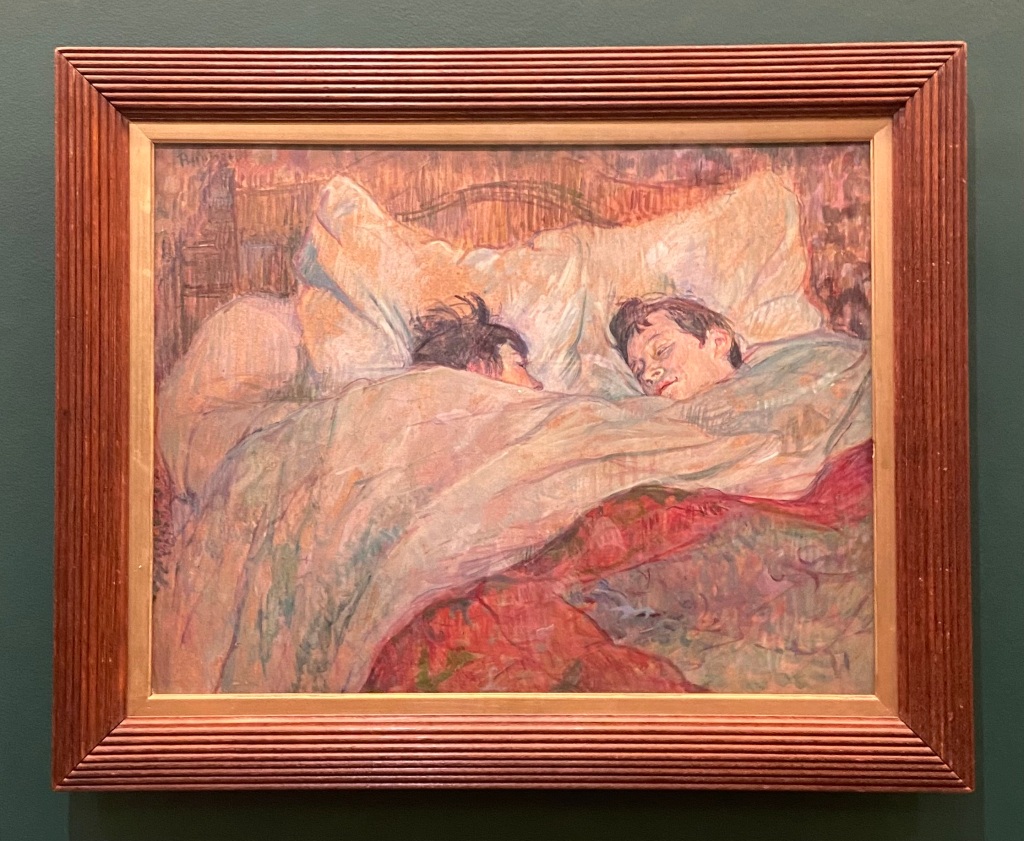
“Love?“
Once upon a time, there was an unexpected love affair between two individuals who’s story lives on through the ages. An accomplished philosopher named Abelard met the intelligent Heloise, who was living with her uncle, a respectable man named Fulbert, in Paris. Abelard was drawn to Heloise’s intellect as he knew that she was well known to be a great scholar and well-versed in Latin, Greek and Hebrew, according to the Medieval History Online Database. He decided to become her tutor as she was still a student in her early twenties, and he was 37 years old and in his prime as a teacher of philosophy and theology. Abelard seduced Heloise during their time together as teacher and student, and their love affair ended in pregnancy. This caused Abelard to send Heloise to his family home in Brittany, where she could spend her pregnancy in secret and later give birth to a son, named Astrolabe. The couple wrestled with the idea of marrying despite it being the socially acceptable thing to do at the time, since he had technically ruined her chances at a traditional life. But the marriage would have also negatively impacted Abelard’s career and reputation as an intellectual. Ultimately, they were married, and Abelard sent Heloise to a convent at Argenteuil. Upon finding out all that had happened, Heloise’s uncle Fulbert paid men to find Abelard and castrate him, for what he had done to his niece. After his castration, Abelard decided to become an abbot and retired to a religious life, persuading Heloise to do the same and ultimately become an abbess. They were permanently separated for the rest of their lives, only to be reunited in death; but wrote to each other continuously, which are the letters that have kept their love alive through the ages for all to remember their story.
Their legacy is one of fervent love, great intelligence, and true commitment. Both Abelard and Heloise pushed forward the wheel of philosophical theory discussions. Their love letters are some of the most popular to date, an excerpt from one retrieved from Free eBooks reads:
“We may write to each other; so innocent a pleasure is not forbidden us. Let us not lose, through negligence, the only happiness which is left us, and the only one, perhaps, which the malice of our enemies can never ravish from us. I shall read that you are my husband, and you shall see me address you as a wife. In spite of all your misfortunes, you may be what you please in your letter. Letters were first invented for comforting such solitary wretches as myself. Having lost the substantial pleasures of seeing and possessing you, I shall in some measure compensate this loss by the satisfaction I shall find in your writing. There I shall read your most secret thoughts; I shall carry them always about me; and I shall kiss them every moment.”
Letter from Abelard to Heloise
From a young age, little girls are taught of love stories. The love of a prince for his princess or a knight for his trapped damsel in distress. The love between two childhood friends who grew up to marry. The love of two enemies who could not help but overstep the thin boundary between hate and love. The forbidden love of two polar opposites, damned by society.
This love story, however, is one that took a lot of thinking for me to distinguish its legacy. An almost middle-aged man falls for a girl who is barely an adult, manages to become her teacher, seduce her and get her pregnant, marries her in secret, sends her away to a convent, gets castrated by her uncle, becomes a monk and persuades her to become a nun, and they write to each other until they died in separation, only to be reunited forever where we stand today.
At first, I thought, there is absolutely nothing in common between either of these lovers and I, nor their love story. However, in my country of birth, it’s very common to see older men dating very young women. Which is something that made me consider the power of societal influence and standards on things like dating and the variability between cultures. The story of Abelard and Heloise has lived on through the ages as one of the most iconic, but in present north American society their love story is not necessarily acceptable, whereas in other parts of the world such as Cuba, it is. I myself am the child of a long age gap relationship which started in Cuba and was seen as just another relationship, but having started in the United States it would likely be frowned upon, especially due to the fact that it’s not Leo D’Caprio doing it.
We often get caught up in our own opinions, forgetting that what we believe to be right and wrong is heavily influenced by where we are from, where we live and what we learn. Just because to you, or in your society something is frowned upon, doesn’t mean that is the absolute truth. We as a society need to work towards being more open-minded and willing to listen and learn of others’ opinions and beliefs, not just to respond but to truly listen and understand.
References:
“Letters of Abelard and Heloise.” Free eBooks, http://www.gutenberg.org/files/35977/35977-h/35977-h.htm#a_CHII. Accessed 28 July 2023.
Medieval Histories. “A Medieval Love Story – Abelard and Heloise.” Medieval Histories, 5 May 2018, http://www.medieval.eu/medieval-love-story-abelard-heloise/.
Departure as Text
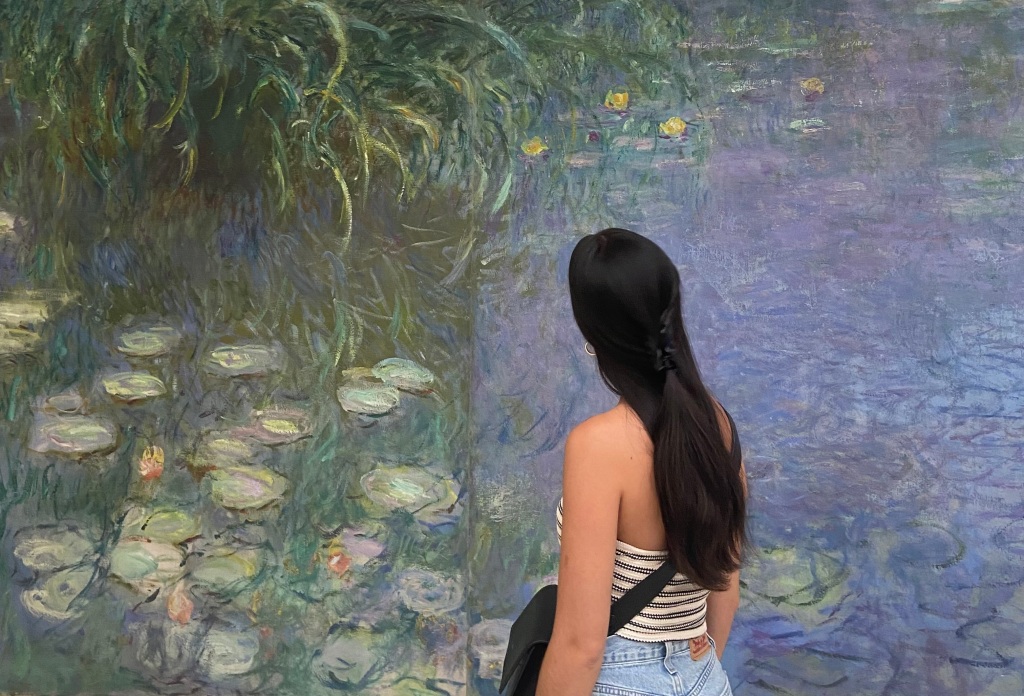
“Education“
After 30 days of exploration around France, the study abroad experience has taught me so much. Both in and out of lecture time, the bonds I’ve created, the experiences that the class has facilitated and the amazing views I’ve seen have come together to fulfill every expectation I set when coming into the experience.
At the start I felt uncertain of what the learning experience would be like. I tried to imagine what the “class” environment would entail while in France, how traveling would factor in and ultimately considered two options. It being either the same as every other class I have taken while in college, which was the least likely, or totally different in an unexpected way. It turned out to be the latter, with the walking lectures being very engaging and the material being intellectually challenging. Unexpectedly, the student interactions were key to my feeling a sense of community, involvement and responsibility in regards to projects and presentations. On one hand, I felt more at ease presenting a project in front of people who I had come to consider friends, but in the other I felt the pressure of wanting to do well and to do the class justice by presenting a good project.
I never expected to feel so emotionally involved with the subjects I studied, nor to grasp information in such a natural way, with barely the need to re-study the material before being tested on it. Being in the places where history took place, and hearing testimony from people who were part of the history is an enthralling experience that has positively affected my learning to say the least.
Like most of us at 20 years old and over, I had already studied most of the subjects we’ve touched upon in class before. From the French revolution to the events of WWII, the artistic styles and the context behind their creation and rise to popularity. However, this class taught me that the best way to truly learn and feel involved with what you’re learning is to surround yourself with the material you want to learn, to immerse yourself in the facts and places. I am reminded of the traditional way in which classroom learning is designed in the United States, and how poorly interactive it is. Learning material for the sake of being tested on it instead of allowing yourself to grow with what you’re learning and learning to connect with new cultures and stories. On social media platforms like YouTube, you can find videos where people visit college campuses and interview random students by quizzing them on information that is commonly taught by 5th grade. The entertainment point is how uninformed and clueless the students are about information pertaining to their own country or topics like geography or government. I now see these videos and the lack of universal awareness or apathy towards education as a potential result of the lack of immersive learning available to students in the U.S..
Growing up a low-income immigrant, travel always seemed like a faraway dream that I could make true once I finished school and worked hard to make money. Now having been able to visit so many places in France and being exposed to such a large amount of culture, art, and history, I feel like I’m making not only my own dreams come true but also the dreams of all those who came before me. Of my parents who’ve worked tirelessly to send me here, of my grandparents who never got the opportunity to visit a foreign country, and of all their ancestors who probably never imagined something like my reality to be possible let alone attainable. I feel blessed to be able to see for myself the palaces, art museums, battle fields, beaches, and mountains where history has been made. Where the foundations for universal human rights came to be. This academic experience has truly influenced the way I perceive education, travel and history. I consider travel a more essential part of personal development than I did before. I now feel the responsibility to ensure as best I can that generations after me have the opportunity to pursue learning abroad. Additionally, it has shaped my idea of what the ideal life looks like. In my family, we seek a life of comfort and stability, which I still value and strive for. But now, after having the experience of studying abroad, I value developing myself as an individual through connecting with and learning about foreign cultures and their history.
No se puede esperar nada menos ,hija de su madre .muchas felicidades por todos sus logros y sacrificios.Orgullo cubano 🥰
LikeLike